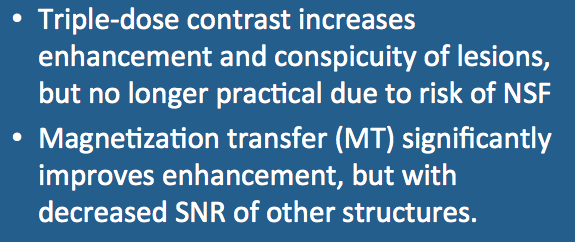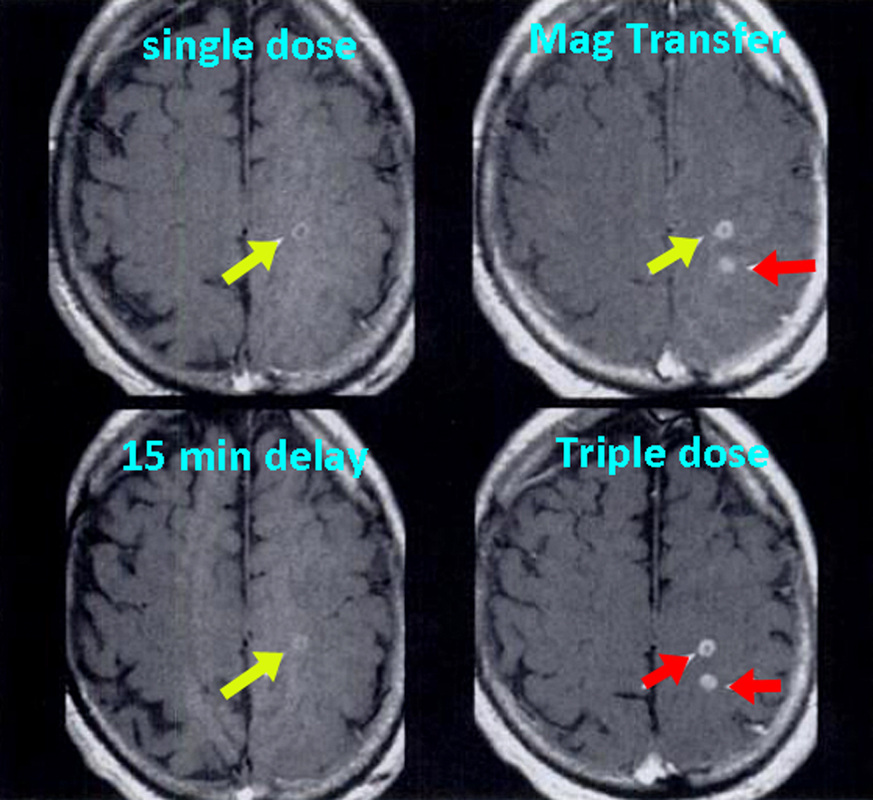In the 1990's considerable research efforts were devoted to the use of double- and triple-dose (0.2 and 0.3 mmol/kg) gadolinium contrast for detecting brain lesions. Higher dose contrast was associated with greater degrees of enhancement, improved conspicuity, and increased confidence in the detection of small lesions. This could be especially important in the evaluation of intracranial metastatic disease where exact number of metastases had important prognostic and therapeutic implications. Several drug companies (Berlex, Bracco) conducted clinical trials to prove the safety and effectiveness of high-dose contrast for routine use.
Due to the higher costs associated with triple-dose regimens as well as increase in flow-related artifacts, the widespread use of high-dose contrast never materialized. Whatever interest remained was further squelched in the late 2000's with the recognition that high-doses of gadolinium might place patients at risk for nephrogenic systemic fibrosis.
|
Magnetization transfer imaging (MTI) is an alternative method for obtaining increased conspicuity of enhancement using only a single dose of contrast. MTI uses off-frequency RF-pulses to saturate the "bound pool" of macromolecules. Because contrast enhancement is due to a direct water-gadolinium interaction and not mediated by macromolecules, it is not affected by the MT pulse. Contrast enhancing areas are rendered more conspicuous on MT images, rivaling that of triple dose contrast.
|
Unfortunately, MTI has never caught on because the images appear noisy and they are commonly affected by "shine-through"-like artifacts from other short T1 or long T2 lesions. Both precontrast and postcontrast MT images must be acquired to assure that one is really seeing contrast enhancement rather than one of these artifacts.
Advanced Discussion (show/hide)»
In addition to triple dose contrast and MT imaging, the use of subtraction imaging was at one time considered a possible method for improving detection of contrast enhancement. However, patient motion between the pre- and post-contrast images often creates artifacts that can resemble marginal contrast enhancement. Registration programs have improved, but have not completely eliminated this problem.
References
Elster AD, King JC, Mathews VP, Hamilton CA. Cranial tissues: appearance at gadolinium-enhanced and nonenhanced MR imaging with magnetization transfer contrast. Radiology 1994; 190:541-546.
Elster AD, King JC, Mathews VP, Hamilton C. Improved detection of gadolinium enhancement using magnetization transfer imaging. Neuroimaging Clin N Am 1994; 4:185-192.
Suto Y, Caner BE, Tamagawa Y, et al. Subtracted synthetic images in Gd-DTPA enhanced MR. J Comput Assist Tomogr 1989;13:925-8.
Ulmer JL, Mathews VP, Hamilton CA, Elster AD, Moran PR. Magnetization transfer or spin-lock? An investigation of off-resonance saturation pulse imaging with varying frequency offsets. AJNR Am J Neuroradiol 1996; 17:805-819.
Yuh WTC, Engelken JD, Muhonen MG, et al. Experience with high-dose gadolinium MR imaging in the evaluation of brain metastases. AJNR 1992; 13:335-345.
Elster AD, King JC, Mathews VP, Hamilton CA. Cranial tissues: appearance at gadolinium-enhanced and nonenhanced MR imaging with magnetization transfer contrast. Radiology 1994; 190:541-546.
Elster AD, King JC, Mathews VP, Hamilton C. Improved detection of gadolinium enhancement using magnetization transfer imaging. Neuroimaging Clin N Am 1994; 4:185-192.
Suto Y, Caner BE, Tamagawa Y, et al. Subtracted synthetic images in Gd-DTPA enhanced MR. J Comput Assist Tomogr 1989;13:925-8.
Ulmer JL, Mathews VP, Hamilton CA, Elster AD, Moran PR. Magnetization transfer or spin-lock? An investigation of off-resonance saturation pulse imaging with varying frequency offsets. AJNR Am J Neuroradiol 1996; 17:805-819.
Yuh WTC, Engelken JD, Muhonen MG, et al. Experience with high-dose gadolinium MR imaging in the evaluation of brain metastases. AJNR 1992; 13:335-345.
Related Questions
What is magnetization transfer?
How is contrast generated by magnetization transfer? Also, what are MTI, MTC, and MTR?
What is magnetization transfer?
How is contrast generated by magnetization transfer? Also, what are MTI, MTC, and MTR?

